

Managing my heart failure

My self-management guide for heart failure
Heart failure is a chronic disease and does not just “go away.” To prevent symptoms or complications, follow this guide.
Discomfort or swelling in the abdomen/ feeling full Loss of appetite or constantly feeling full with
Needing more pillows under your head to sleep
breathing while laying flat or unable to lie flat
What is heart failure?
Heart failure is a condition in which the heart has trouble pumping blood because it has become weak or stiff. This means that the heart does not pump blood efficiently for the body to work well. For some people with heart failure, fluid may back up into the lungs or there may be swelling (edema) in the lower legs or abdomen. Heart failure is usually a long-term (chronic) condition. It is important for you to take good care of yourself and follow your treatment plan (use My Self-Management Guide for Heart Failure).
What puts me at risk for or causes my heart failure?

High blood pressure
Heart attack
Coronary artery disease
Heart muscle disease
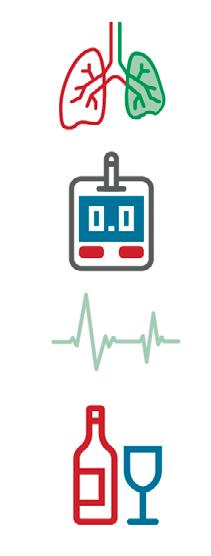
Lung disease
Diabetes
Irregular heartbeat (arrhythmia)
Drinking too much alcohol (cardiomyopathy or myocarditis)
Abnormal heart valves
What type of heart failure do I have?
It is possible to have one or both types of heart failure. The 2 types are systolic and diastolic heart failure.
I have systolic heart failure—this means my heart is not able to pump out as much blood from my heart and it can sit there in my ventricles (bottom of my heart).
I have diastolic heart failure—this means the ventricles (bottom of my heart) are stiff or do not relax, causing my heart to fill with less blood.
Ejection fraction
Ejection fraction (or EF) is a measurement of the amount of blood that the heart pumps out during each beat. It is often measured through an echocardiogram (or echo)—an ultrasound of your heart.
• A healthy heart pumps out 50% to 70% of blood during each beat.
• If you have systolic heart failure, your EF is typically reduced, often below 40%.
• If you have diastolic heart failure, your EF may be within normal range, but there is less blood in the heart that is being pumped out, as the heart is not relaxing properly to allow all the blood to get in.
Heart failure medications
Heart failure is a progressive disease; however, there are many medications that can help to manage your heart failure.
• Take all medications as prescribed by your physician.
• Do not skip doses—even when you feel good.
• Do not stop taking your medicine for any reason, unless you discuss this with your doctor first. If you have any issues getting your medication as prescribed, contact your doctor.
I am taking a...The name of my pill is...
ACE inhibitor or ARB
Beta blocker
Diuretic (Water pill)
Neprilysin inhibitor plus an ARB or ARNI
SLGT2 Inhibitor
Other medications:
This will...
Reduce the workload of my heart.
This may also lower my blood pressure.
Slow my heart rate to allow more time for blood to fill the heart and may block substances made by my body that make heart failure worse.
This may also lower my blood pressure and keep my heart rate in a normal rhythm.
Get rid of the extra fluid in my body, which can make breathing easier and decrease swelling.
If I have to take a diuretic two times a day, taking my last dose before 6 p.m. will make it less likely that I will need to use the bathroom during the night.
Improve my heart’s ability to pump blood.
Help my heart pump better, block substances made by my body that make heart failure worse, raise my potassium, or lower my blood pressure.
*This chart includes common heart failure medications that you may be prescribed.
Notes...
Low sodium diet
Limit your sodium intake
Eating too much salt (also called sodium) can cause your body to hold extra fluid. This can make your heart work harder and can make your heart failure symptoms worse. To keep your heart healthy, limit your sodium intake. Your doctor may prescribe you to eat or drink no more than 2 - 3 grams per day.
Ways to lower the sodium in your diet:
• Flavor your foods with herbs and spices instead of salt. Adding salt to foods can make your sodium intake add up quick. One teaspoon of salt is about 2,300 mg of sodium. Salt-free herb blends, like Mrs. Dash®, are a great way to flavor food. See page 7 for other herb and spice suggestions.
• Salt substitutes, like Nu-Salt® or Morton® Salt Substitute, are generally not recommended because they contain potassium. Check with your doctor first if you decide to use these.
• Choose whole, unprocessed foods as much as possible. Processed foods tend to contain more sodium. The Food Suggestions table on the next page contains tips about which foods are healthy and which should be limited or avoided.
• Limit restaurant and fast food meals to 2 meals per week or less. These meals typically contain high amounts of salt, so try to eat more meals at home.
Using the nutrition facts label
Start by looking at the serving size. All of the information on the nutrition facts label is based on 1 serving. If you eat more or less than 1 serving, you will have to adjust the information on the label based on that amount. Sodium is listed in milligrams (mg). You might want to limit sodium to 500 to 600 mg per meal if you eat 3 meals per day, to keep your sodium intake low. Compare the number on the label with your daily goal to stay under your allowance.
Avoid foods that contain more than 300 mg in a serving size.
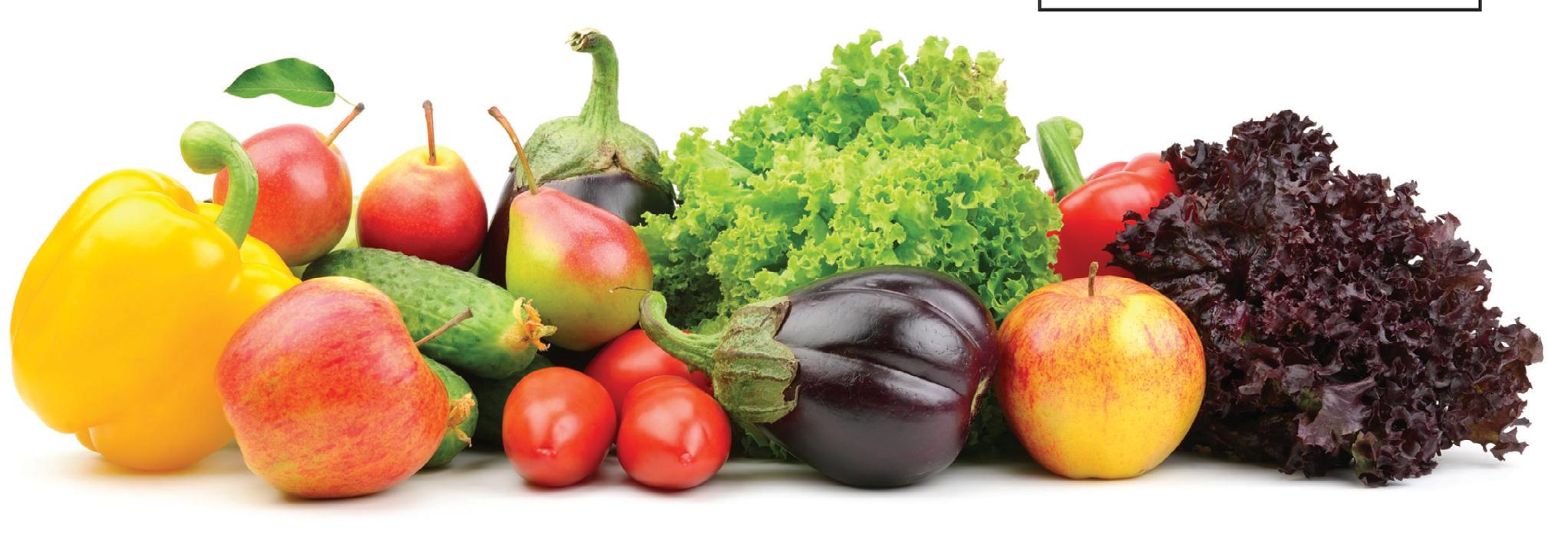
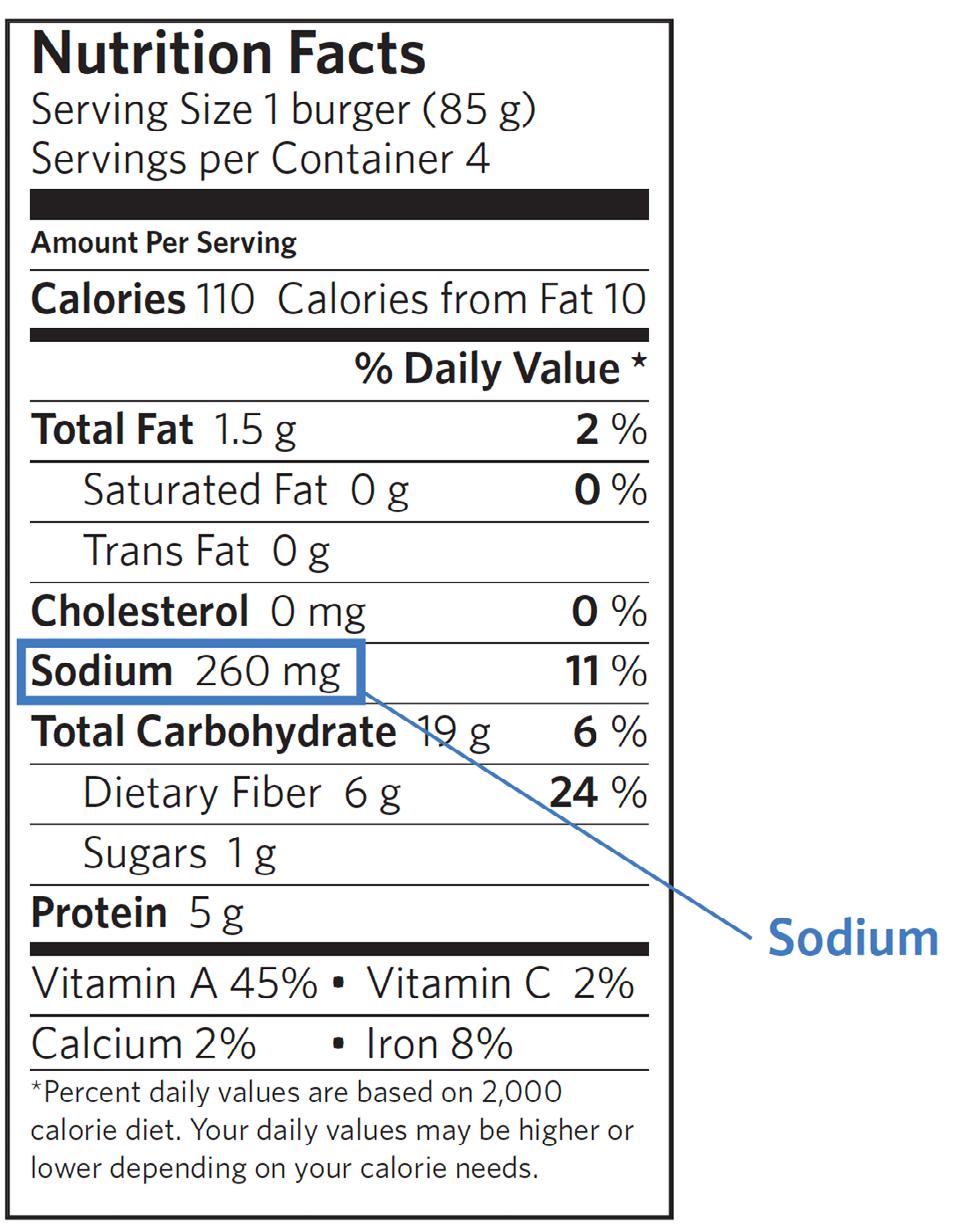
Low sodium food options
Food group
Beverages
Choose these foods
• Water, coffee, tea, decaffeinated coffee
• Carbonated beverages
Avoid these foods
• Dutch-processed cocoa
• Sports drinks
• Energy drinks
• Any above allowed fluid amount
Breads, cereals and starches
6 to 11 servings
• Low-sodium breads, muffins, tortillas
• Unsalted crackers, pretzels and popcorn
• Brown rice, barley, whole wheat pasta and other pastas cooked without salt
• Homemade bread stuffing
• Unsalted cooked cereals and low-sodium dry cereals
• Bread, rolls and crackers with salted tops; salted snacks such as pretzels, potato chips, popcorn
• Store-bought bread stuffing; regular bread crumbs or cracker crumbs
• Store-bought rice or pasta mixes
• Instant-cook cereals
• Rolls, pancakes or biscuits made from mixes or refrigerated dough
Fruit
2 to 4 servings
Vegetables
3 to 5 servings
• Fresh or frozen fruit, or fruits canned in their own juice
• Fruit juices
• Dried fruits
• Fresh and frozen vegetables
• Low-sodium canned vegetables
• Low-sodium tomato juice and low-sodium V8® vegetable juice
• Fruits processed with salt or sodium
Meat and meat substitutes
5 to 6 ounces per day
• Unsalted fresh or frozen beef, lamb, pork, veal, poultry or game
• Eggs and liquid egg substitute
• Fresh or frozen fish, shrimp or clams. Low-sodium canned tuna or salmon
• Low-sodium cheese
• Cottage cheese (limit to 1/4 cup daily)
• Tofu and unsalted peanut butter
• Low-sodium canned beans or dried beans such as split peas, garbanzo, kidney, pinto, etc.
• Any prepared with salt or sodium
• Regular tomato or vegetable juices
• Frozen vegetables in sauces
• Instant, frozen or dehydrated potatoes, french fries
• Smoked, salted or dried meats such as ham, bacon, sausage, salt pork, deli meats, hot dogs, pickled meats, frozen breaded meats, jerky
• Pickled eggs, egg substitute with cheese, dry egg substitute
• Canned tuna, salmon, sardines and anchovies; imitation crab, lobster, pickled and marinated herring
• All cheeses, hard and processed, cheese spreads and sauces, unless unsalted
• Regular peanut butter and canned beans
Food group
Milk and yogurt
Limit to 2 servings per day
1 servings = 1/2 cup
Choose these foods
• Milk, chocolate milk and yogurt
• Soy and almond milk
Avoid these foods
• Buttermilk
• Condensed milk
• Commercially prepared breakfast drinks, malted milk
• Any milk exceeding allowed fluid amount
Soup
• Unsalted homemade soups made from allowed foods and milk
• Low-sodium canned soups or bouillon
• Regular canned, frozen or dehydrated soup or bouillon
• Any exceeding allowed fluid amount
Desserts
Fats, oils and sweets
Use sparingly
Miscellaneous
• Homemade cake, cookies and fruit pies made without salt
• Homemade pudding
• Ice cream, sherbet, vanilla wafers and gelatins
• Unsalted gravy, butter, margarine, salad dressings, vegetable oils, homemade gravies
• Unsalted nuts, coconut
• Prepared horseradish, homemade salsa, mustard, low-sodium ketchup
• Flavoring extracts, chocolate (avoid Dutch-processed), chocolate syrup, jam and jelly
• Unsalted snacks
• Pepper, Mrs. Dash®, dry mustard, herbs, spices, vinegar, lemon or lime juice, Tabasco sauce
• Instant pudding mixes
• Cakes, cookies and muffins made from mixes
• Other desserts made with salt
• Regular salad dressings and gravies, bacon fat
• Olives, salted nuts, pickles, soy sauce, regular ketchup, Dijon mustard, Worcestershire sauce, steak sauce, chili sauce, marinades, horseradish sauce, dried celery and nondairy creamers
• Salted snacks.
• Boxed or canned convenience foods
• Frozen meals, lunches, pizza or snacks
• Store-bought sauces such as pasta, meat or entrée sauces
• Meat extracts, meat tenderizers, monosodium glutamate (MSG/ Accent®), onion salt, garlic salt or celery salt
• Reduced-sodium salt or sea salt
Suggestions for herbs and seasonings
Herb-blend recipes
1 tablespoon onion powder
1½ teaspoon basil leaves
½ teaspoon ground celery seed
½ teaspoon paprika
½ teaspoon chili powder
Herbs and seasonings
Allspice
Basil
Bay leaves
Caraway seeds
Celery powder
Chili powder
Chives
Cider vinegar
Cinnamon
Cloves
Curry powder
Dill/Dill seed
Fennel seed
Garlic (fresh or powder)
Ginger
Lemon juice
Mace
Marjoram
Mint leaves (dry or fresh)
Mustard (dry or fresh)
Nutmeg
Oregano
Paprika
Parsley
Pepper (black or red)
Rosemary
Sage
Thyme
In a small bowl, blend all ingredients. Store in airtight container. Use in place of salt for sprinkling over cooked foods.
Use with
Ground beef, meatloaf, tomatoes, squash, all fruits
Beef, lamb, veal, pork, asparagus, squash, green beans, wax beans
Beef, lamb, pork, poultry, tomatoes
Beef, lamb, pork, salads, asparagus, carrots, cabbage, noodles, breads
Soups, salads, deviled eggs
Ground beef, cauliflower, corn, peas, eggs
Meats, vegetables, salads, eggs
Meats, salads, beets, spinach
Pork, ground beef, carrots, squash, spinach, sweet potatoes, breads, fruits
Beets, carrots, squash, sweet potatoes, pears, applesauce
Meats, tomatoes
Tomatoes, beets, carrots, cauliflower, peas, potatoes
Pork, poultry, seafood
Meats, vegetables
Chicken, beef, fruits, beets, carrots
Beef, lamb, poultry, fish, vegetables
Ground beef, veal, breads, fruits
Beef, lamb, pork, veal, poultry, eggplant, zucchini, potatoes, eggs, canned fruits
Lamb
Ground beef, veal, chicken, eggs, onions, tomatoes
All fruits, corn, carrots, cauliflower, potatoes
Ground beef, veal, chicken, eggs, onions, tomatoes
All meats, all vegetables
All meats, all vegetables
Salad, meats, fish, eggs, vegetables
Potatoes, vegetables, meats
All meats, tomatoes, green beans, eggplant, squash
All meats, eggs, peas, carrots, tomatoes, green beans
Modifying my lifestyle risk factors: Alcohol,
tobacco, weight and blood pressure
Modifying my lifestyle risk factors
Along with diet, exercise and taking the medicines you are prescribed, there are some lifestyle changes you may be able to make to keep your heart from worsening. Talk to your doctor if you have any questions or need help.
Alcohol and tobacco
Drinking alcohol and using tobacco can harm your heart.
Avoid drinking alcohol
• Alcohol does not mix well with heart failure medications and can weaken your heart.
• It is best to avoid alcohol.
• Talk to your doctor if you drink regularly.
Quit smoking/using tobacco
• Do not smoke or chew tobacco, and stay away from secondhand smoke.
• Even if you have tried to quit before, keep trying! It can take multiple attempts to successfully quit. Talk to your doctor about options to help you quit smoking.
Weight
• Maintain a weight that promotes a normal body mass index.
• Obesity can add stress to your heart and increase your blood pressure.
Blood pressure
• It is important to monitor your blood pressure.
• Your diet and weight can affect your blood pressure.
• Take your medicine as prescribed and notify your doctor if you have any problems maintaining your blood pressure goal.
Keep moving
Aerobic exercise is the best form of exercise for your heart. It involves repeated, sustained use of your large muscles, such as those in your arms and legs. Some examples are walking, biking and swimming.
Guidelines for exercise
• Wait at least 1 hour after eating a meal.
• Avoid exercising in extreme heat (80 degrees Fahrenheit and higher), humidity (75% and above) or cold (less than 32 degrees Fahrenheit).
• Avoid or walk slower on hilly terrain.
• Pace yourself. It’s OK to stop and rest, if needed. Try to walk longer than your rest breaks. Repeat intervals of walk/rest as able to progress to your goal.
• Do not exercise if you:
– Are not feeling well.
– Feel short of breath at rest.
– Are dizzy or light-headed.
• Try these techniques to control your breathing and avoid shallow, rapid breathing:
– Pursed-lip breathing: Breathe in through the nose (as if smelling flowers), and slowly out through pursed lips (as if blowing bubbles).
– Diaphragmatic breathing (belly breathing): Place one hand on stomach and your other hand on upper chest. Deeply inhale, feeling lower hand push out; slowly exhale through pursed (puckered) lips, feeling lower hand sink back in toward stomach. Very little chest movement should be felt by hand over upper chest.
If you have diabetes
• Beginning an exercise program may affect your blood sugar. You may need to talk with your doctor to have your medications adjusted.
• Do not exercise on an empty stomach. It is best to exercise between 1 to 3 hours after eating a meal.
• Try to exercise at about the same time every day to help keep your blood sugar more level.
• Stop exercise if you are having symptoms of low blood sugar, such as shakiness, dizziness, loss of coordination or concentration, excessive sweating, or fatigue. You may need juice, candy or a glucose tablet to raise your blood sugar.
Stop exercise and rest if you experience any of the following symptoms:
• Pain, pressure or tightness in your chest, upper back, arms or jaw.
• Irregular pulse, very rapid heartbeat, or sudden increase or decrease of pulse.
• Dizziness or light-headedness.
• Nausea, vomiting or cold sweat.
• Inability to catch your breath.
• Sudden confusion or lack of coordination.
• Sudden weakness/numbness of face, arm or leg.
• Changes in vision.
• Difficulty with speaking or understanding speech.
• Excessive fatigue.
Call your doctor if these symptoms occur for the first time, become more severe, or happen more often when you are exercising. Call 911 if the symptoms continue after resting.
Use the Rating of Perceived Exertion (RPE) scale to determine how hard to push yourself. The following scales help you monitor how hard you are exercising. You should be able to walk and talk comfortably at the same time. Your goal is to stay between 11 and 16.
* Back down 1 level if your RPE is very hard for you.
Use the Rate of Perceived Dyspnea (RPD) or Shortness of Breath Scale to the right to help monitor your breathing.
severe shortness of breath (you can only say 1 word at a time)
of breath is so severe you need to stop activity and rest (you cannot talk)
Exercises
Warm-up: Preparing your heart for exercise
• Do pursed-lip breathing as needed with warm-up and cool-down exercises.
• Complete each of the following exercises 10 times slowly while sitting or standing. Or walk/bike slowly for five minutes.
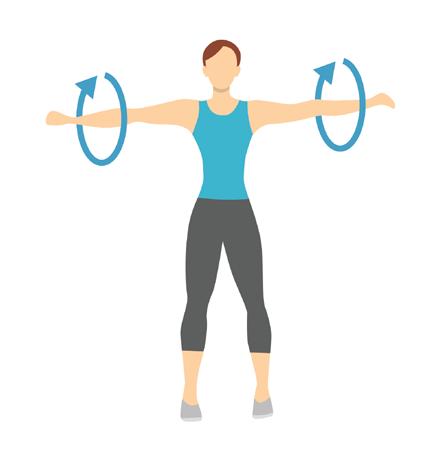

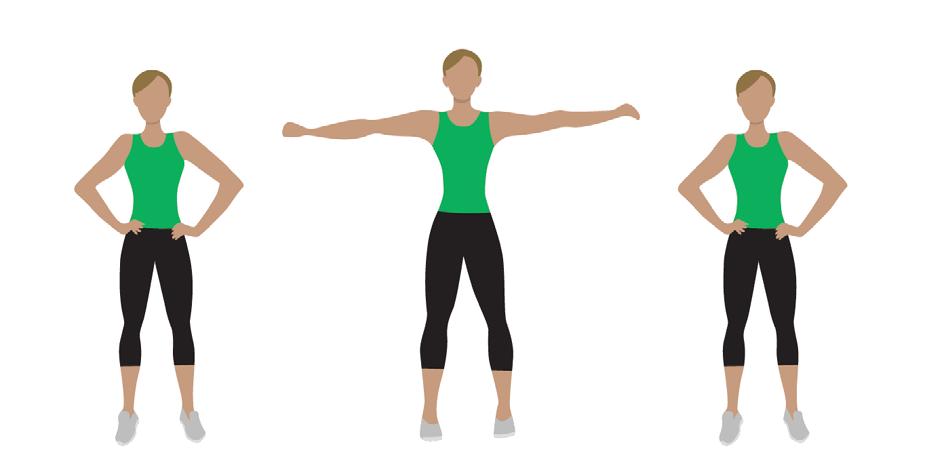

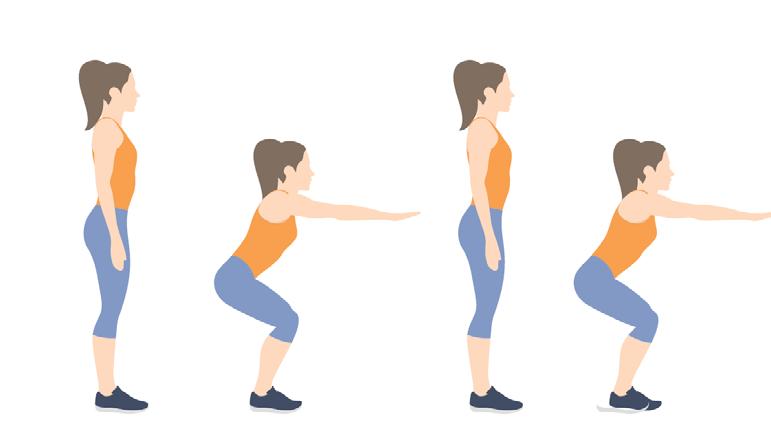
Slight knee bends (hold on for balance)
Aerobic biking/walking program
• Exercise __________ minutes with a RPE/RPD between __________ and __________ /10, __________ sessions per day.
• Try to add __________ minutes per __________.
• Your goal is __________ minutes __________ times a day.
• Try to do this five to seven days per week.
Cool down: Repeat the above exercises 10 times slowly or walk/bike slowly for 5 minutes.
Arm circles
Shoulder and arm bends
Trunk side bend Standing, rocking on toes (hold on for balance)
Progress monitoring log
DateWeightBlood
(minutes) RPE
Target Is 11-16/20
Were you short of breath / RPD Score? How do you feel?
Stress and emotions
Managing your stress and emotions
Stress is a fact of life, and it is often a part of living with a chronic disease. Having a chronic disease also increases your chances of developing depression. Dealing with depression is more serious than dealing with stress. To help manage your stress levels and prevent depression:
• Become aware of what causes your stress to start (your stress triggers).
• Practice identifying how your stress affects you physically, mentally and emotionally.
• Identify the best methods to deal with the current stress.
– If you cannot directly resolve your stress, try to accept it and move on.
– If you cannot accept or change your stress, think about what you can do to help yourself feel better physically, mentally or emotionally.
• Ask for support from people you trust, such as friends and family.
– Share your feelings.
– Keep in touch.
• Take good care of yourself.
– Be active and exercise regularly.
– Develop self-soothing skills, such as meditation, positive self-talk, yoga or listening to music.
– Get enough sleep.
– Treat yourself when you feel stressed, such as by getting a massage or taking a hot bath.
– Avoid overeating, drinking a lot of alcohol, smoking or using drugs.
– Do not try to do too many things in a day.
• Continue to manage your disease.
– Follow My Self-Management Guide for Heart Failure.
Relationships
Having a chronic disease can be difficult for you and for your loved ones. It is important to realize that your loved ones, especially your spouse or significant other, may also be feeling stress. Your loved ones may:
• Worry about you and about seeing you in pain.
• Need to talk with someone about their feelings related to your illness. They may benefit from a support group for caregivers.
• Take on the role of caregiver for you. In some cases, this may make you feel angry or you may feel like their care is taking away from your self-care.
• Need clear guidelines from you about how they can be most supportive. Ask them for what you want, such as having their company or being left alone.
It is important to care for yourself both physically and emotionally
When you experience stress, you may not be able to manage your heart failure as well as you could if your stress was under control. It is important to recognize when you need help and to speak to your doctor if you notice any of the following:
• You feel nervous, guilty or emotionally “empty”.
• You have trouble focusing, remembering or making decisions.
• You feel life is not worth living or have thoughts of death, suicide or self-harm.
• You have sleep problems like trouble falling asleep, waking up in the middle of the night or sleeping too much.
• You are eating either more or less than usual.
• You do not enjoy things that you used to enjoy.
Get help right away if:
• You have thoughts about hurting yourself or others.
• If you ever feel like you may hurt yourself or others, or have thoughts about taking your own life, get help right away. You can go to your nearest emergency department or call:
– Your local emergency services (911 in the U.S.).
– A suicide crisis helpline, such as the National Suicide Prevention Lifeline at 988 This is open 24 hours a day.

Self-management tools
My baseline
My belt buckle usually fits into the _____________________ hole.
I can walk from _____________________ to ______________________ before becoming short of breath.
I can climb __________________ stairs before becoming short of breath.
Other baselines:
Notes
My heart medications
My symptoms chart
Use this chart to track your weight, blood pressure and heart rate every day. Also keep track of changes in symptoms or any special notes. Bring it with you when you visit your health care team. (The chart contains enough space for two weeks).
baselines
Advanced care planning
What is advance care planning?
Advance care planning is a process that enables you to make plans about your future care. It provides direction to health care professionals if you are unable to make or communicate your choices.
Why does it matter?
It identifies and prepares the person you want to be making your health care decisions if you are unable to do so on your own. You are able to share what matters most.
What should I do next?
If you have already created an advance directive, great! Please bring it to your next appointment and discuss with your provider (physician, physician assistant or nurse practitioner). To create an advance directive, contact a member of your health care team for support.
Are there helpful resources to get started?
• Making Choices Michigan Advance Directive Document.
• The Conversation Project Starter Kit. of people say it’s important to put their wishes in writing. of people have actually done it. 97% 37%

One conversation can make all the difference.

This handout does not take the place of a discussion with your health care team. Discuss any questions or concerns you may have with your health care team. Approved for distribution by System Patient Education Council.
X31279 (digital guide of X09938) © Corewell Health 07.2025
